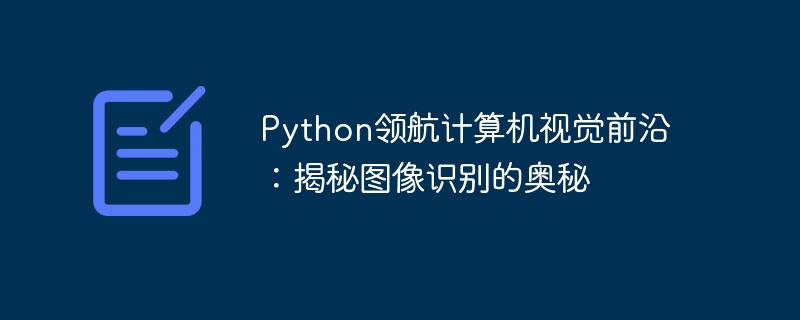

Computer vision is a branch of artificial intelligence designed to enable computers to understand the content in digital images or videos. Image recognition is an important task in computer vision, which involves identifying and classifying objects or scenes in images. pythonWith its powerful image processing library and deep learningframework, it is the leader in the field of computer vision.
1. Python image processing library
Python provides a rich image processing library, allowing developers to easily process and analyze images. The most popular libraries include OpenCV, Pillow and Scikit-Image.
1. OpenCV
OpenCV is an open source computer vision library that provides a series of image processing and computer vision algorithms, including image reading, writing, conversion, edge detection, and contour search , feature extraction, etc.
2. Pillow
Pillow is an image processing library that provides many image processing functions, including image loading, saving, cropping, rotation, scaling, etc. Pillow also supports a variety of image formats, such as PNG, JPEG, GIF, TIFF, etc.
3. Scikit-Image
Scikit-Image is an open source image processing library that provides many image processing algorithms, including image segmentation, morphology, filtering, threshold processing, etc. Scikit-Image also supports a variety of image formats, such as PNG, JPEG, GIF, TIFF, etc.
2. Python deep learning framework
Deep Learning is a branch of machine learning that solves complex learning tasks by using artificial neural networks . Deep learning has achieved great success in the field of image recognition, allowing computers to accurately identify objects or scenes in images.
1. TensorFlow
Tensorflow is an open source deep learning framework that provides a variety of deep learning algorithms, such as convolutional neural network, recurrent neural network, generative adversarial network, etc. TensorFlow also provides many pre-trained models, allowing developers to quickly build and train deep learning models.
2. PyTorch
PyTorch is an open source deep learning framework that provides a flexible computational graph to enable developers to easily build and train deep learning models. PyTorch also provides many pre-trained models, allowing developers to quickly build and train deep learning models.
3. Keras
Keras is an open source deep learning library that provides high-level api to enable developers to easily build and train deep learning models. Keras supports TensorFlow and PyTorch as backends, allowing developers to easily switch between different deep learning frameworks.
3. Python image recognition practice
The following is a demo code for image recognition using Python:
import cv2
import numpy as np
# 加载图像
image = cv2.imread("image.jpg")
# 转换图像为灰度图像
gray = cv2.cvtColor(image, cv2.COLOR_BGR2GRAY)
# 使用Sobel算子进行边缘检测
edges = cv2.Sobel(gray, cv2.CV_64F, 1, 0, ksize=5)
# 使用Canny算子进行边缘检测
edges = cv2.Canny(gray, 100, 200)
# 显示图像
cv2.imshow("Original Image", image)
cv2.imshow("Gray Image", gray)
cv2.imshow("Sobel Edges", edges)
cv2.imshow("Canny Edges", edges)
# 等待用户输入
cv2.waiTKEy(0)
# 关闭窗口
cv2.destroyAllwindows()This code first loads the image and then converts it to a grayscale image. Next, use the Sobel operator and the Canny operator for edge detection. Finally, display the image and wait for user input.
4. Summary
Python takes the lead in the field of computer vision with its powerful image processing library and deep learning framework. This article introduces the use of the Python image processing library and deep learning framework, and shows how Python implements the mystery of image recognition through demonstration code.
The above is the detailed content of Python leads the frontier of computer vision: revealing the secrets of image recognition. For more information, please follow other related articles on the PHP Chinese website!




